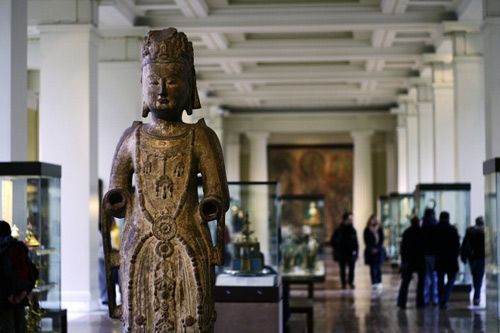Academics explore role of cultural circulation in world, history

An exhibit full of Chinese elements at a museum in Europe
Scholars from China, France and Switzerland got together in Shanghai recently to shed light on cultural circulation and its role in the contemporary world and the past.
The 13th China-France-Switzerland History and Culture Workshop was held at East China Normal University from Sept. 4 to 9 under the theme “Circulations of Cultures: Europe and China.”
A new trend has arisen in the field of new cultural history, or history of society and culture: Growing numbers of global academics are using “circulation” instead of “transmission” to describe the movement of culture.
“In the past two decades, historians have frequently employed the concept of international circulation,” said Robert Frank, a professor emeritus of history at Pantheon-Sorbonne University.
“International circulation” means cross-border circulation of any form and content, including not only personnel, commodities and capital but also ideas and ideology, as well as cultural products, like books, music works, lifestyles and social practice models, Frank said.
Shen Jian, president of the Chinese Society of French Historical Studies, noted that the word “circulation” is based on commodity circulation in economics, and French sociologist Pierre Bourdieu extended its meaning to the realm of ideas.
Demand not only drives commodity circulation but also the circulation of ideas and cultures, Shen said, adding that studies of cultural circulation should focus on the demand from idea receivers to explore how cultures are interpreted and interact with one another.
“Culture itself is truly rich and diverse, and cultural diversity and differences constitute the reason why cultures circulate,” said Wang Chaoguang, deputy director of the Institute of World History at the Chinese Academy of Social Sciences.
In the contemporary economic, political and cultural spheres, it is vital to recognize the richness of others’ culture and understand mutual differences, Wang said.
Though it has undergone rapid development, economic globalization has been challenged in terms of cultural diversity. Brexit, US President Donald Trump’s “America First” policy and the emergence of the National Front in the French election all reflect attitudes of different countries toward economic globalization. Scholars at the workshop concurred that the world remains a closely tied community, while communication and interaction among diverse cultures have reached an unprecedented degree.
Christophe Charle, a professor from Pantheon-Sorbonne University and École normale supérieure (ENS), said that cultural circulation is bourgeoning across the world, but it existed a long time ago. In the 19th century, with the rapid development of steamships, trains, telegraph, telephones, newspapers and printing, there was an explosion in cultural circulation.
Charle pinpointed the period as a key turning point in the history of global cultural circulation, saying that Europe at the time adopted channels like culture, consumption and media to exert influences on other regions in the world while shaping its soft power during circulation of different cultures.
Stressing that the world is undergoing dramatic changes, Feng Shaolei, a professor from the School of Advanced International and Area Studies at East China Normal University, said that if countries confine themselves to immediate issues and persist in their own views, no valuable ideas will come along. They should study history to understand human society and provide references for the contemporary era, Feng added.
Circulation of cultures has yielded new perspectives for historical studies. Franks said that in the 1980s, historians emphasized cultural transmission. In the 1990s and the first decade of the 21st century, transnational historical research and a shift of focus in global historical studies helped scholars better understand various changes of spatial form that took place during cultural transmission and circulation, while evaluating how subjects and objects evolve in the process, he added.
Cultural circulation is closely related to the evolution of the international relations regime, Feng argued. For example, when it comes to the evolution of music in Europe, the diversified, balanced melodies of Bach’s polyphony provide a window into the essence of the Westphalian system, while Beethoven’s works can help deepen the understanding of the status of Europe before and after the Vienna system was established.
Moreover, modernism at the turn from the 19th to 20th century was essential to explaining the booming scientific and technological development and the rise of nationalism, Feng said. Integrating history and cultural studies to reveal and elucidate changes in human society is an important mission for humanities researchers, he added.
LI YU and ZHA JIANGUO are reporters at the Chinese Social Sciences Today.

 PRINT
PRINT CLOSE
CLOSE